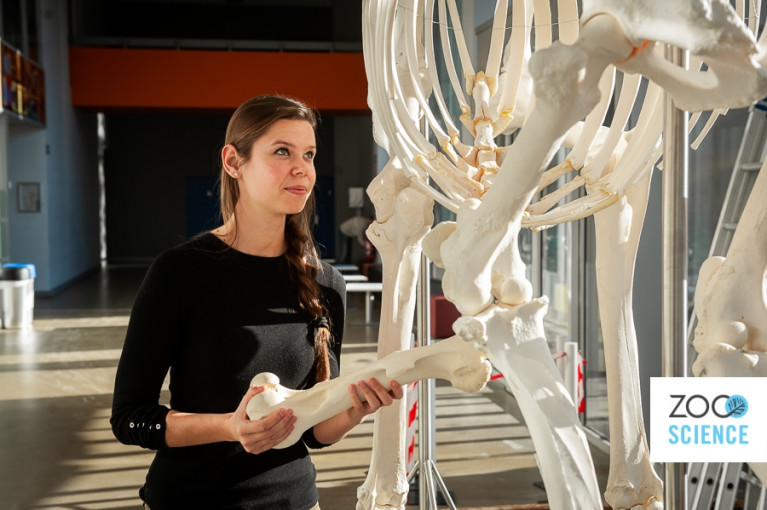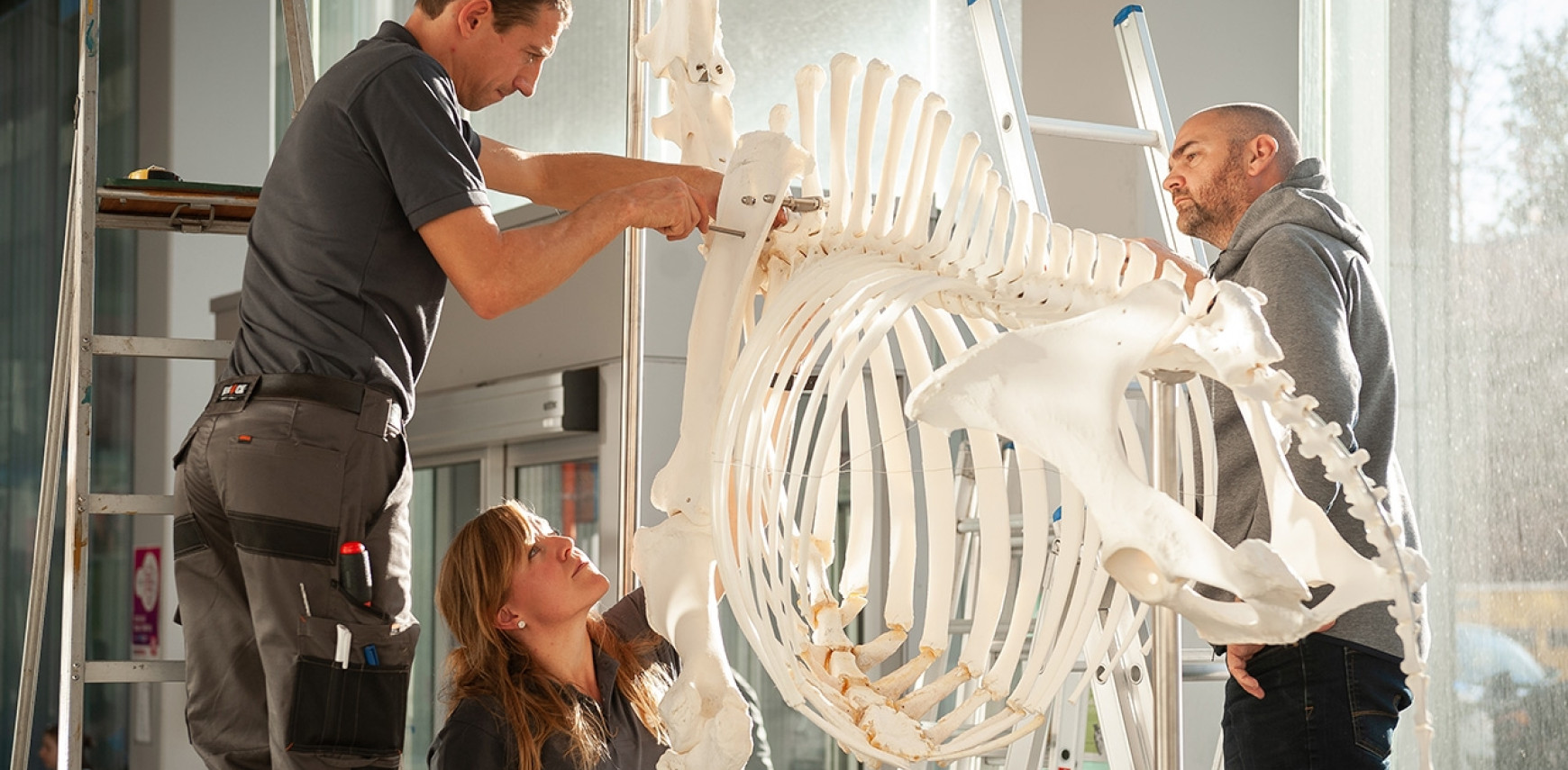A second life for Dana
Dana the giraffe, who died in 2017 at 20 years of age at Antwerp ZOO, is getting a second life at the University of Antwerp. Not only is the mounted skeleton stealing the show in the hall of the S Building on the Drie Eiken campus, students of veterinary medicine can also work with various parts of Dana. “A giraffe may seem like odd study material, certainly here in Belgium, but our students are taught veterinary medicine in a comparative way,” explains Chris Van Ginneken, Professor of Anatomy at the University of Antwerp. For Antwerp ZOO, it’s very important to contribute to education, at this academic level, as well. “We are extremely conscious of our unique position,” adds Linda Van Elsacker, Director of Zoology at Antwerp ZOO. “We have a unique collection of exotic animals, and a death like this offers a unique opportunity to introduce the veterinarians of the future to various life forms, or biodiversity.”
HOW EXACTLY DOES THIS COLLABORATION WORK?
D175 years ago, the founders of Antwerp ZOO envisioned a very clear mission. Science, nature and education would be the three pillars of our mission. Those three pillars shine through when we consider an iconic species like the giraffe. As long as the animals live, it is clear what stories we can tell. But once a giraffe dies, a new story begins. In other words, a whole new world opens up. “Of course, deaths like these are emotional – particularly for zookeepers – but for our scientists, they represent the start of a new chapter,” explains Linda Van Elsacker, Director of Zoology at Antwerp ZOO. “And our veterinarian knows which other researchers, institutes and museums are interested in a giraffe, or in one of our other species, once it has passed away. That’s how the University of Antwerp, an important research partner for us, appeared on our radar when Dana the giraffe died a year and a half ago at the ripe old age of 20. It goes without saying that future veterinarians are extremely interested in being able to work with the full panoply of biodiversity. For us, it’s very important to contribute to education, at this academic level, as well,” Van Elsacker elaborates, “since we are extremely aware of our unique position with our collection of exotic animals.”
Antwerp ZOO: "The University of Antwerp, an important research partner for us”
So, in mid-2017, the University of Antwerp received the skeleton of our giraffe Dana. It was dissected, prepared and mounted again in the hall of Building S on the Drie Eiken campus. “It is not only on display, but also used by students of veterinary medicine, biology, medicine and physical therapy, who can use it in comparative studies,” explains Chris Van Ginneken, Professor of Anatomy at the University of Antwerp. “The skeleton has been mounted in such a unique way that pieces of it can be removed. The skull can be removed, as can the neck, but so can the front and hind legs. That way, students can take the body part from the exhibition space to the lab, where they can more closely compare the animal to the skeletons of other species we have here. That is really unique.”
WHAT IMPACT DOES THIS COLLABORATION HAVE?
Before Dana’s skeleton was put back together, each bone was scanned with an X-ray device, so that three-dimensional simulations can be made. “We can also use those in researching the relationship between the shape and function of a certain body part,” Van Ginneken continues. “And that is research that happens together with the Biology Department, but also with Antwerp ZOO staff. Using 3D, we can make all kinds of simulations and, for example, starting with a specific shape – the position of the tendons – conjecture about certain functions of that body part. Of course, that also needs to be tested, to see whether it is actually true in living animals. And that automatically brings us back to Antwerp ZOO. We hope to be able to work with them again during that phase, in order to complete that research.”
University of Antwerp: “A giraffe may seem like odd study material – certainly here, in Belgium – but our students are taught veterinary medicine in a comparative way.”
“A giraffe may seem like odd study material for a student of veterinary medicine – certainly here, in Belgium – but our students are taught using the comparative method,” says Van Ginneken. “They study the vertebrae of a dog, a Chihuahua, but they also study those of a cow or a horse. A giraffe has seven cervical vertebrae, as well, but there are a couple of special features that make its neck more flexible. And that is what is so interesting to us: getting students to examine an exotic species in an extra-comparative way. For example, it was only discovered very recently why a giraffe, at a weight of 1000 kg supported by four limbs, can stay on its feet so well. It’s no easy feat. But it turns out that there is a tendon running along the back of a bone, all the way to the toes. A deep groove is completely filled by a sturdy tendon. In most animals, the first rib begins at the last cervical vertebra. But in a giraffe, it’s all the way down at the first thoracic vertebra, which explains why the giraffe’s neck mobility is so much greater than that of, say, a horse. Now, our students can study all of that themselves.”
Bachelor of Veterinary Medicine student Sofie Vercammen, is extremely enthusiastic: “This is a real asset to us. Learning on an exotic animal like this is a unique experience. Normally, we can only compare skeletons of cows, horses or small pets. I can’t wait to start working with it and discover new things.”

It speaks to the imagination: the long neck of a giraffe. And yet, it consists of the same basic parts, seven vertebrae, as other mammals’ necks. “But it functions completely differently and is put together differently,” adds Van Elsacker. “That’s what it comes down to for the students: gaining an understanding of the amazing variation in biodiversity. What’s more, Dana’s skeleton is no longer simply the remains of a deceased giraffe, but a source of information for the many students of veterinary medicine who can learn more about the vagaries of biodiversity,” states Van Elsacker. “Sometimes, we also use the term ‘sustainable enterprise.’ It may sound a little strange. But sustainable enterprise doesn’t just mean working efficiently with our animal collection, engaging in exchanges with other zoos, keeping animals healthy and having them breed. Sustainable enterprise also means not letting any materials go to waste when animals die. You could call it ‘upcycling.’”
University of Antwerp: “We have learned a lot from this first collaboration, for example, how to mount a skeleton with removable parts, and we really hope to continue down this path. There are already a number of new projects in the pipeline.”
“Making Dana’s skeleton available is a first step in studying the skeleton of an exotic species, together with Antwerp ZOO and students. There are a number of new projects in the pipeline to continue that in the future. We have learned a lot from this first collaboration, for example, how to mount a skeleton with removable parts, and we really hope to continue down this path,” states Van Ginneken.

